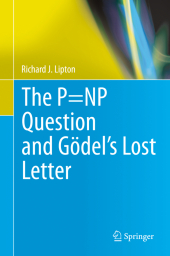 Neuerscheinungen 2010Stand: 2020-01-07 |
Schnellsuche
ISBN/Stichwort/Autor
|
Herderstraße 10
10625 Berlin
Tel.: 030 315 714 16
Fax 030 315 714 14
info@buchspektrum.de |

Richard J. Lipton
The P=NP Question and Gödel´s Lost Letter
2010. xiii, 239 S. 20 SW-Abb.,. 235 mm
Verlag/Jahr: SPRINGER, BERLIN 2010
ISBN: 1-441-97154-8 (1441971548)
Neue ISBN: 978-1-441-97154-8 (9781441971548)
Preis und Lieferzeit: Bitte klicken
? DoesP=NP. In just ?ve symbols Dick Karp -in 1972-captured one of the deepest and most important questions of all time. When he ?rst wrote his famous paper, I think it´s fair to say he did not know the depth and importance of his question. Now over three decades later, we know P=NP is central to our understanding of compu- tion, it is a very hard problem, and its resolution will have potentially tremendous consequences. This book is a collection of some of the most popular posts from my blog- Godel Lost Letter andP=NP-which I started in early 2009. The main thrust of the blog, especially when I started, was to explore various aspects of computational complexity around the famousP=NP question. As I published posts I branched out and covered additional material, sometimes a timely event, sometimes a fun idea, sometimes a new result, and sometimes an old result. I have always tried to make the posts readable by a wide audience, and I believe I have succeeded in doing this.
The Problem.- G odel´s Lost Letter.- Cook´s Insight.- Karp Hits Twenty-One.- Nondeterminism.- Why Polynomial Time?.- P=NP and Insider Baseball.- The Knapsack Problem: An Exponential Algorithm.- A Nightmare about P=NP.- The One Page Challenge.- P=NP and Big O Notation.- More Abuse of O-Notation.- Our Problem is More Important Than Your Problem.- The Magic of P 6= NP.- P=NP and the End of Security.- The LBA Problem.- P=NP and The Three Bears.- Bait and Switch: Why Lower Bounds Are So Hard.- The Knapsack Problem: A Lower Bound.- There are Big Circuits Out There.- Knapsack: An Upper Bound.- Hilbert and P=NP.- Are All NP-Complete Problems The Same?.- The Real P=NP Problem.- P=NP in Other Worlds.- P=NP and the Structure of the World.- Do Impossibility Results Matter?.- Circuit Lower Bounds.- The Core of a Problem Who is Afraid of Natural Proofs?.- False Proofs by Famous People.- Cryptography Turned Upside Down Ramsey´s Theorem Meets P=NP.- Shooting Down Proofs P=NP.- Where are the Movies?.- P=NP : What are the Odds?.-
"This book is a thoroughly enjoyable read because of the great balance between anecdotes, presentations of ´nice´ problems and algorithms and their solutions and proofs, ´hard mathematics,´ and musings on how to approach mathematical problems. After having read the book, most readers with a background in complexity theory will most likely be unable to resist immediately working on at least one of the many open problems presented in the book." (Till Tantau, Mathematical Reviews, October, 2015)
"This book ... collects and edits the highlights from Lipton´s ongoing blog, rounded out by cross-references and a useful index and bibliography. ... the book offers a different experience and a framed portrait of the state of the art. ... Summing Up: Recommended. All levels/libraries." (D. V. Feldman, Choice, Vol. 48 (9), May, 2011)
"The P=NP question is certainly one of the most important problems in mathematics and computer science (CS). What makes this book unique and delightful is that it gives proper weight to the question rather than the technicalities. Each chapter is based on one of Lipton´s blog posts, and readers can jump from chapter to chapter to find his beautifully written thoughts and insights. ... In fact, anyone who is highly motivated by this interesting subject that relates science with reality should read it." (Hector Zenil, ACM Computing Reviews, March, 2011)
"This book collects some entries of the author´s blog on G ö del´s lost letter and P = NP ... . It is an enjoyable and lively introduction to some impressive achievements in the field of complexity theory." (Thierry Coquand, Zentralblatt MATH, Vol. 1215, 2011)


